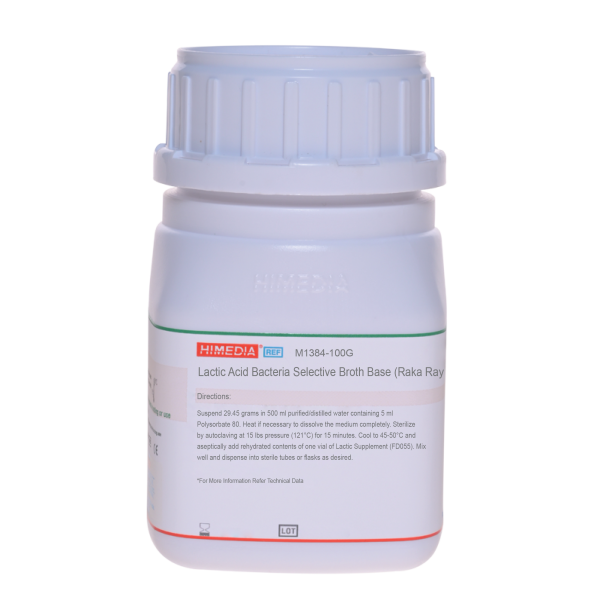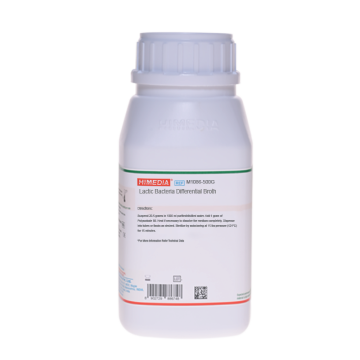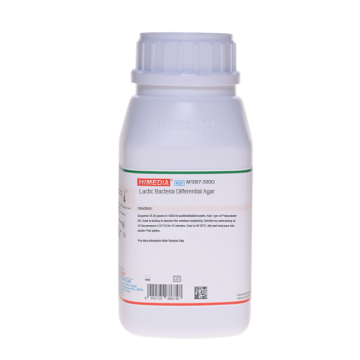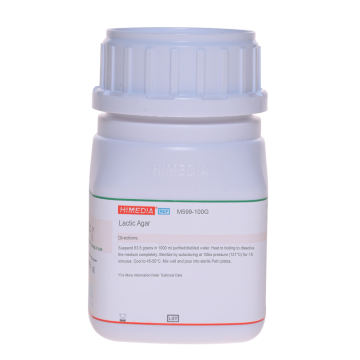 Your enquiry has been submitted
Your enquiry has been submitted
Lactic Acid Bacteria Selective Broth Base (Raka Ray No. 3 Broth Base)
Intended Use:
Recommended for selective isolation of lactic acid bacteria encountered in beer and the brewing process.
Composition**
| Ingredients | Gms/Litre |
|---|---|
| Tryptone | 20.000 |
| Yeast extract | 5.000 |
| HL extract# | 1.000 |
| Maltose | 10.000 |
| Fructose | 5.000 |
| Dextrose (Glucose) | 5.000 |
| Betaine hydrochloride | 2.000 |
| Diammonium hydrogen citrate | 2.000 |
| L-Aspartic acid | 2.500 |
| Magnesium sulphate | 0.980 |
| Manganese sulphate | 0.420 |
| Dipotassium hydrogen phosphate | 2.000 |
| N-acetyl glucosamine | 0.500 |
| Potassium glutamate | 2.500 |
Final pH (at 25°C): 5.4±0.2
**Formula adjusted, standardized to suit performance parameters # Equivalent to Liver extract
Directions
Suspend 29.45 grams in 500 ml purified/distilled water containing 5 ml Polysorbate 80. Heat if necessary to dissolve the medium completely. Sterilize by autoclaving at 15 lbs pressure (121°C) for 15 minutes. Cool to 45-50°C and aseptically add rehydrated contents of 1 vial of Lactic Supplement (FD055). Mix well and dispense into sterile tubes or flasks as desired.
Principle And Interpretation
Lactic Acid Bacteria Selective Medium was formulated by Saha, Sondag and Middlekauff to monitor the brewing process and analyze it for a wide range of bacteria (10). These media are also recommended by the American Society of Brewing Chemists (ASBC) and the European Brewing Convention (EBC) (1,8). Lactic Acid Bacteria Selective Medium was found to be superior to several other media for the cultivation of Lactobacilli and Pediococci (2,3,11). Lactic Acid Bacteria Selective Broth Base also suppressed the growth of non-lactic acid facultative bacteria that are often associated with lactic beer spoilage (9).
Yeast extract, tryptone and HL extract serve as sources of carbon, nitrogen, vitamins, amino acids and essential nutrients. Dextrose (glucose), maltose and fructose serve as sources of carbon and energy. Fructose is an essential carbohydrate for the growth for Lactobacillus fructivorans (11). Maltose helps to detect glucose non-fermenting lactobacilli (6). Polysorbate 80, maltose, yeast extract and N-acetyl glucosamine stimulates growth of lactobacilli (7). Various salts provide trace elements. Cycloheximide and phenyl ethanol (as FD) serves to inhibit yeast and gram-negative organisms respectively.
Type of specimen
Brewery samples
Specimen Collection and Handling
After use, contaminated materials must be sterilized by autoclaving before discarding.
Warning and Precautions
Read the label before opening the container. Wear protective gloves/protective clothing/eye protection/face protection. Follow good microbiological lab practices while handling specimens and culture. Standard precautions as per established guidelines should be followed while handling specimens. Safety guidelines may be referred in individual safety data sheets.
Limitations
- Further biochemical and serological tests must be carried out for complete identification.
Performance and Evaluation
Performance of the medium is expected when used as per the direction on the label within the expiry period when stored at recommended temperature.
Quality Control
Appearance Cream to beige homogeneous free flowing powder
Colour and Clarity of prepared medium Dark amber coloured clear solution in tubes.
Reaction Reaction of 5.89% w/v aqueous solution at 25°C. pH : 5.4±0.2
pH 5.20-5.60
Cultural Response Cultural characteristics observed under anaerobic condition, with added Lactic Supplement (FD055), after an incubation at 25-30°C for 18-48 hours.
| Organism | Inoculum (CFU) | Growth |
|---|---|---|
| Lactobacillus acidophilus ATCC 11506 | 50-100 | good-luxuriant |
| Lactobacillus plantarum ATCC 8014 | 50-100 | good-luxuriant |
| Lactobacillus fermentans ATCC 9338 | 50-100 | good-luxuriant |
| Lactobacillus brevis ATCC 367 | 50-100 | good-luxuriant |
| Lactobacillus buchneri ATCC 11307 | 50-100 | good-luxuriant |
| Pedicoccus acidilactis ATCC 8042 | 50-100 | good-luxuriant |
| Escherichia coli ATCC 25922 (00013*) | >=104 | inhibited |
| Saccharomyces cerevisiae ATCC 9763 (00058*) | >=104 | inhibited |
Key : (*) Corresponding WDCM numbers.
Storage and Shelf Life
Store between 10-30°C in a tightly closed container and the prepared medium at 2-8°C. Use before expiry date on the label. On opening, product should be properly stored dry, after tightly capping the bottle in order to prevent lump formation due to the hygroscopic nature of the product. Improper storage of the product may lead to lump formation. Store in dry ventilated area protected from extremes of temperature and sources of ignition. Seal the container tightly after use. Product performance is best if used within stated expiry period.
Disposal
User must ensure safe disposal by autoclaving and/or incineration of used or unusable preparations of this product. Follow established laboratory procedures in disposing of infectious materials and material that comes into contact with sample must be decontaminated and disposed of in accordance with current laboratory techniques (4,5).
Reference
- European Brewing Congress, EBC Analytica Microbiologica, 1981, J. Inst. Brewing 87:303-321.
- Hsu W. P., and Taporowsky J. A., 1977, Breweries Digest, 52: 48.
- Hug H., Schlienger E. and Pfenniger H., 1978, Braveri- Rundschau, 89.145
- Isenberg, H.D. Clinical Microbiology Procedures Handbook 2nd Edition.
- Jorgensen, J.H., Pfaller, M.A., Carroll, K.C., Funke, G., Landry, M.L., Richter, S.S and Warnock., D.W. (2015) Manual of Clinical Microbiology, 11th Edition. Vol. 1.
- Lawrence D. R. and Leedham P. A., 1979, J. Inst. Brewing, 85. 119.
- Mauld B. and Seidel H., 1971, Breauwissenchaft, 24.105
- Methods of Analysis of ASBC, 1976, 7th Edi., The Society, St. Paul Mn USA
- Report of the Technical Subcommittee, 1976, Microbiological Controls, J. Am. Soc. Brewing Chemists 34:93-94.
- Saha R. B., Sondag R. J. and Middlekauff J. E., 1974, An improved medium for the selective culturing of lactic acid bacteria, Proceedings of the American Society of Brewing Chemists, 9th Congress, p. 9-10.
- VanKeer C., Van Melkebeke L., Vertriest W, Hoozee G. and Van Schoonenberghe E., 1983, J. Inst. Brewing, 89:360-363.
| Product Name | Lactic Acid Bacteria Selective Broth Base (Raka Ray No. 3 Broth Base) |
|---|---|
| SKU | M1384 |
| Product Type | Regular |
| Physical Form | Powder |
| Origin | Animal |
| Packaging type | HDPE |
| References | 1. Saha R. B., Sondag R. J. and Middlekauff J. E., 1974, An improved medium for the selective culturing of lactic acid bacteria,Proceedings of the American Society of Brewing Chemists, 9th Congress, p. 9-10. |
| Customized Product Available | No |









